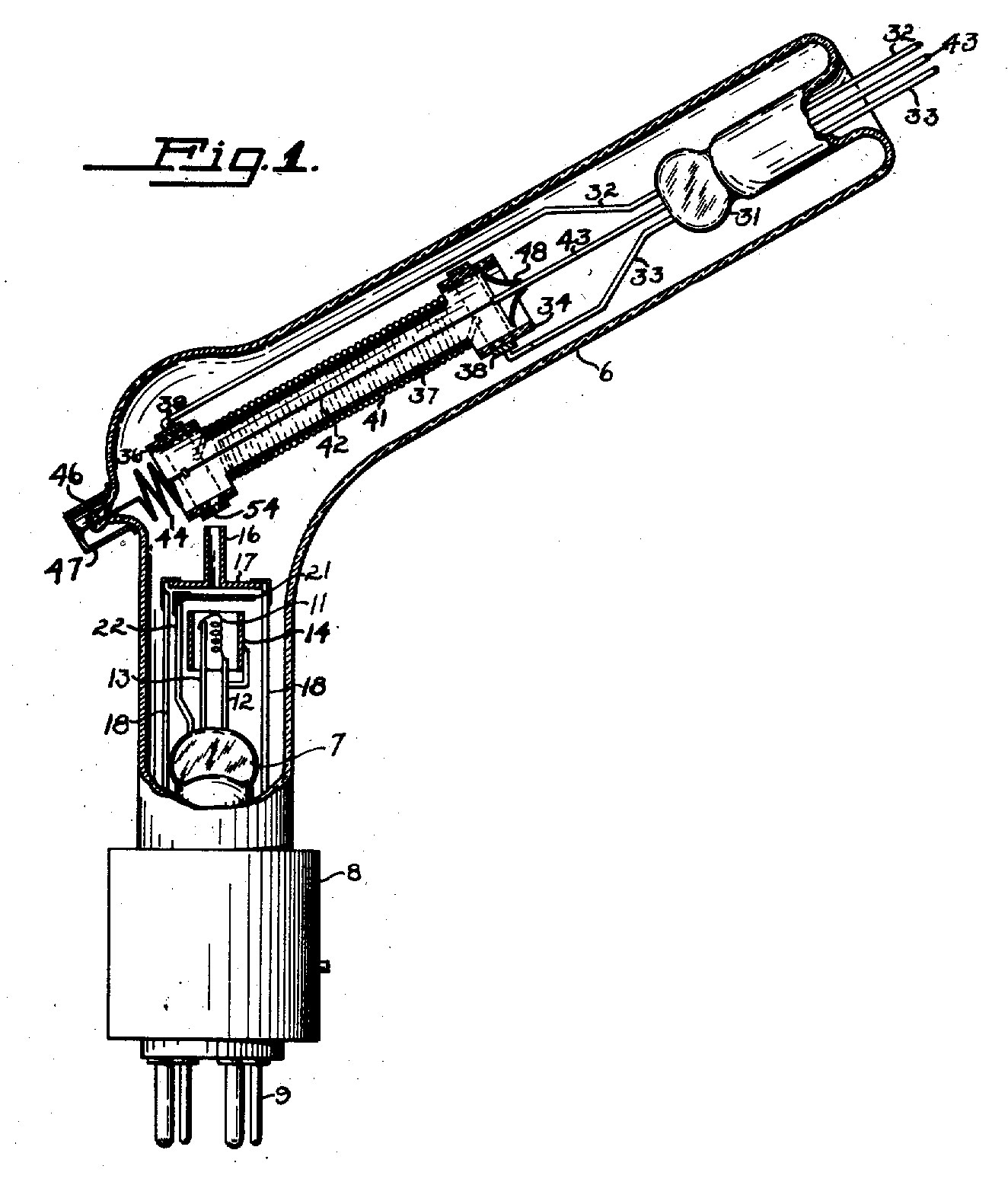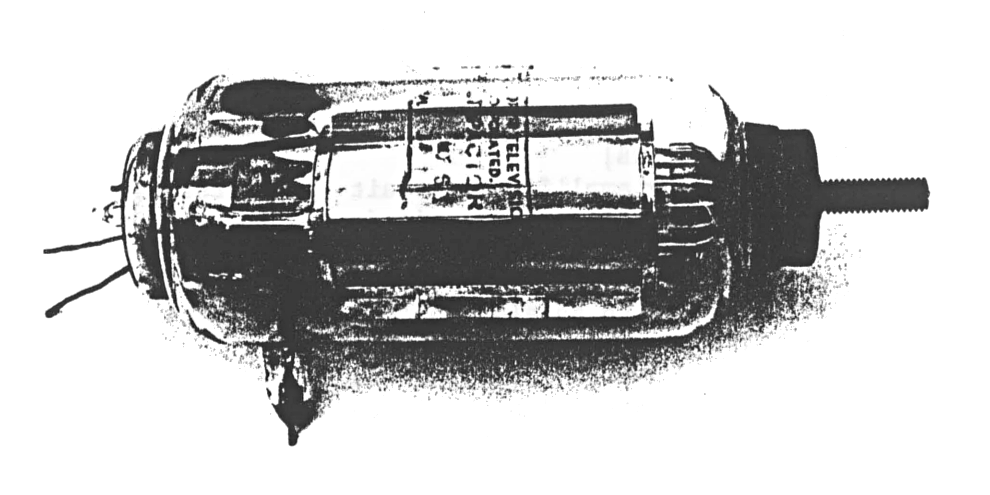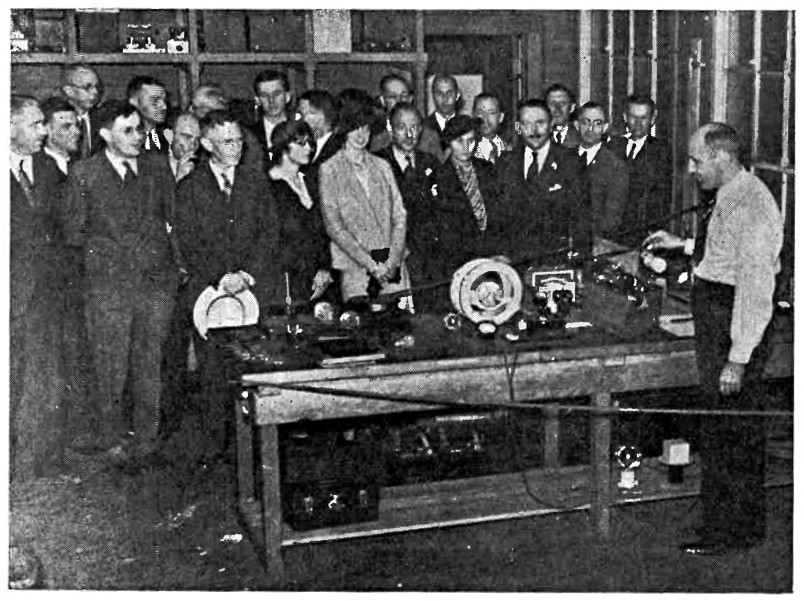
A new chapter in radio history is written. The Illustration shows Mr. Ralph M. Heintz adjusting a 50-watt R.F. Amplifier which is being driven by the sensationally new Farnsworth Electron Multiplier Tube. This new tube uses neither filament nor grid. "Among those present" in the photo are Dr. Leonard Fuller, Dr. F. E. Terman, Arthur H. Halloran, Herbert E. Metcalf, Donald Lippincott, George Everson, and other radio engineers and scientists.
The Farnsworth Multipactor Tube
“Farnsworth’s Cold-Cathode Electron
Multiplier Tube Uses Neither Grid Nor Filament”
by Arthur H. Halloran
from RADIO (October, 1934)
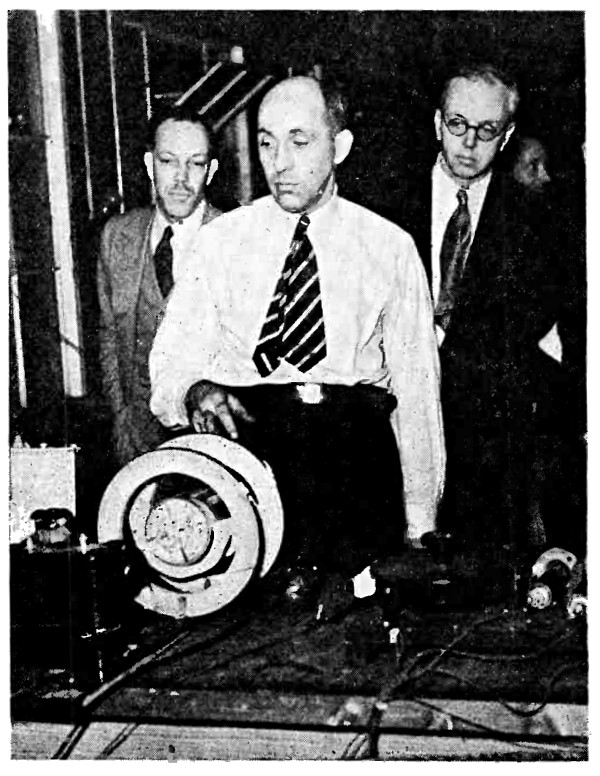 Ralph M. Heintz (center) explains the operation of the Farnsworth Cold Cathode Tube to Bernanrd H. Linden (left), U.S. Radio Inspector and Donald Lippincott (right), director of Television Laboratories, Inc.
Ralph M. Heintz (center) explains the operation of the Farnsworth Cold Cathode Tube to Bernanrd H. Linden (left), U.S. Radio Inspector and Donald Lippincott (right), director of Television Laboratories, Inc.
Think of a vacuum tube without filament or grid, thus requiring neither an A nor a C battery, which generates high-frequency oscillations! This is what Philo Taylor Farnsworth II, the television genius, accomplishes with the cold-cathode tube which he originally developed as a current-amplifier for use with his cathode-ray pickup tube. It is also an exceedingly efficient detector and modulator.
Its first public use as an oscillator was in a radio circuit whereby communication was maintained between San Fransisco and Honolulu and between San Fransisco and New York on September 13, 1934, over the Globe Wireless 35-meter channel. In this test, with 30 milliamperes at 1100 volts on the anode, the tube drove a pair of 150-watt tubes in the final amplifier of a transmitter at the Heintz & Kaufmann factory in South San Fransisco. The signals were received at both Honolulu and New York, and were reported as R9 by a ship 500 miles west of Honolulu.
Wilkens of Dunedin, New Zealand, also heard the transmissions. Previous laboratory tests proved that the tube is capable of generating oscillations of any desired frequency throughout the range from 200 kilocycles to 60 megacycles, these limits being set only by the dimensions of the available tuned circuits. An undistorted output of 25 watts was obtained from an input of 25 watts.
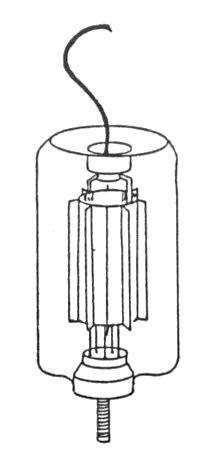 Fig. 2. Multipactor Tube
Fig. 2. Multipactor TubeAS AN AMPLIFIER
The performance of this new type of tube depends upon the emission of secondary electrons from two cathodes which are bombarded with high-velocity primary electrons. The cathodes are coated with caesium silver oxide to enhance secondary emission. They, together with a central ring anode, are assembled in an evacuated glass tube. The tube is placed within a solenoid which is supplied with direct current so as to maintain an intense magnetic field throughout the length of the tube. When used as an amplifier, a high frequency voltage is applied to the cathode terminals and a D.C. voltage is applied to the anode terminal to hold it at a positive potential with respect to the cathodes, which are shunted by a coil and variable condenser in parallel. The shunt circuit is tuned so as to be in resonance for the applied high frequency voltage.
When the D.C. voltage is applied to the anode terminal, any free electrons in the inter-electrode space would immediately be drawn to the anode were it not that the longitudinal magnetic field neutralized the transverse electrostatic field from the anode and were it not for the high-frequency electrostatic field which draws them to the alternately positively charged cathodes. The strength of these several fields can be adjusted to allow an electron to be shuttled back and forth in a zig-zag path between the cathodes any desired number of times before it is finally drawn out of circulation at the anode.
Each time that a high velocity electron strikes a cathode it causes the emission of from 2 to 8 secondary electrons, the number of secondaries depending upon the velocity of the impacting electron, and thus upon the amplitude of the voltage applied to the cathodes. Each emitted secondary likewise causes the emission of more secondaries, so that the process is rapidly cumulative and gives rise to a tremendous amplification of current.
In the foregoing simplified account of the tubes operation as an amplifier, one important factor has been omitted. The anode attraction, which causes an electron to leave the vicinity of a cathode and which accelerates its velocity as it approaches the plane of the anode, also decelerates its velocity as it leaves the anode plane and approaches the second cathode, which is now positively charged so as to attract it. Its resultant velocity may therefore not be sufficient to cause emission from the second cathode. To insure emission, additional energy must be imparted to it, this energy being obtained from that stored in the resonant circuit.
The high-frequency supply is of the order of 50 megacycles and is loosely coupled to the tuned circuit so as to apply from 25 to 90 volts across the cathode terminals. The positive potential on the anode may be 100 volts or more, depending upon the desired current output.
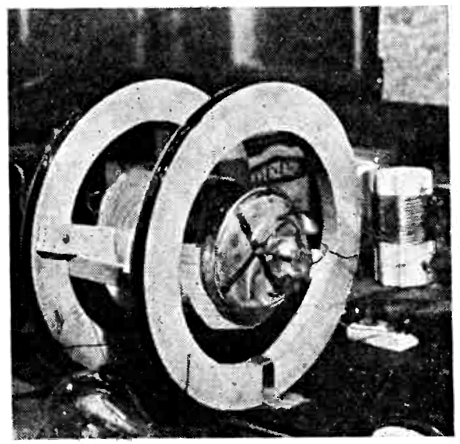 The Electron Multiplier as a high-frequency self-excited oscillator.
The Electron Multiplier as a high-frequency self-excited oscillator.
The tube has a discontinuous voltage-current output characteristic with a series of successively higher current peaks as the voltage is increased. Maximum current output is obtained when the anode voltage is just sufficient to allow an electron to travel from one cathode to the other during 1/2 cycle of the high frequency excitation. Other successively lower peaks occur at anode voltages corresponding to transit times of 3/2, 5/2, 7/2, 9/2 cycles, the last being the least which has yet been measured.
The external magnetic field is unnecessary when the cathodes are properly curved instead of being plane. Their curvature can be calculated to focus the electrons automatically for specified anode and cathode voltages. This eliminates the need of a D.C. supply for magnetic focusing.
The tube’s theoretical output is twice that of an equivalent hot-cathode tube operated as a Class A amplifier. Its practical output is limited by the ability of the cathodes to withstand the high temperature to which they are subjected by bombardment from a rapidly increasing number of electrons. One test of a small tube showed an output of 100 watts of undistorted energy before the cathodes were destroyed by heat. Such destruction is prevented by means of resistors in the [9] cathode leads. A small tube can be safely operated so as to deliver 45 milliamperes with 200 volts on the anode. It is to be noted that the tube operates as a current amplifier and that the amount of voltage amplification is dependent upon the resistance in the output circuit.
The theory of the tube’s operation as a detector or modulator should be evident from the non-linear voltage-current characteristic and requires no elaboration here. It is especially sensitive in the detection of ultra-high frequencies. [Editor's Note: P.T. Farnsworth III told Eric Dollard that the multipactor tube and the Tesla coil were a marriage made in heaven! TB]
It is a well known fact that any amplifier circuit generates oscillations when arranged to furnish an input voltage of proper magnitude and phase. Consideration of the manner in which Farnsworth’s tube functions as an amplifier shows that it conforms to this requirement when connected to a resonant circuit which is tuned to a frequency whose half-period is equal to an electron’s time of transit, as determined by the frequency of the oscillations applied to the cathodes.
 Oscillator circuit for cold cathode tube.
Oscillator circuit for cold cathode tube.
But the great value of the Farnsworth tube resides in the fact that it is self-exciting, i.e., that it requires no external high frequency voltage when used as an oscillator. Aside from the energy which is required for the magnetic focusing field and which may not be needed eventually, the only external source of energy is that which maintains a positive potential on the anode. It apparently represents a new discovery in vacuum tube phenomena. Among engineers there is a difference of opinion as to its cause.
One plausible explanation is based on the assumption that there is no appreciable space charge effect in the tube when oscillations start. There are always some free electrons present in the inter-electrode space, if only those due to photoelectric emission from the cathodes. These are attracted by the anode when it becomes strongly positive but are prevented from immediately going to it by the longitudinal magnetic field. Their acceleration as they approach the plane of the anode causes a current to flow, through half the inductance coil in the tuned circuit, to one cathode. This provides an out-of-phase voltage drop which accelerates the electrons toward the other cathode with sufficient velocity to cause secondary emission therefrom. The emitted electrons then establish a current flow through the other half of the mid-tapped coil and cause a voltage drop in opposite phase so as to accelerate the electrons toward the first cathode which is thus caused to emit more secondaries. Repetition of this process quickly builds the current up to a point where it can be delivered to the output circuit without stopping the internal oscillations. The oscillating frequency is that to which the resonant circuit is tuned. This explanation has not been confirmed by physicists, but is [10] presented only as a means for visualizing possible actions in the tube. When the engineers disagree, the physicist must experiment.
Much work has yet to be done before standardized tubes will be available for experimental use. Television Laboratories Ltd. has licensed two factories for commercial production. But it will probably be a matter of some months before tubes are available for amateur use.
finis
Mrs. Elma “Pem” Farnsworth has recently lent Eric Dollard and Borderland a Multipactor Tube for testing in our lab. The Multipactor holds promise in the “free energy” field as a truly workable electronic device that may produce over 100% efficiency. The test as noted in the above article claims that “an undistorted output of 25 watts was obtained from an input of 25 watts.” This does not take into account radiated heat and possible residual losses. The Multipactor that Borderland is testing is a perfected model of the unit referred to in this article. It appears as though it actually was used in radio frequency broadcast equipment. Preliminary tests show the tube to be good and further tests are being planned. More information will be released through this Journal as we progress on this project.
For those interested in obtaining more information on the Multipactor Tube the related U.S. Patent numbers for P.T. Farnsworth II are: #1,969,399 – Electron Multiplier, Aug. 7, 1934; #2,071,515 – Electron Multiplying Device, Feb. 23, 1937; #2,071,517 – Multipactor Phase Control, Feb. 23, 1937; #2,135,615 – Multipactor, Nov. 8, 1938; #2,140,285 – Multiplier Coupling System, Dec. 13, 1938; #2,140,832 – Means and Method of Controlling Electron Multipliers, Dec. 20, 1938; #2,141,837 – Multistage Multipactor, Dec. 27, 1938; #2,141,838 – Split Cathode Multiplier Tube, Dec. 27, 1938; #2,143,262 – Means for Electron Multiplication, Jan. 10, 1939; #2,161,620 – Two Stage Electron Multiplier, June 6, 1939; #2,172,152 – Radio Frequency Multipactor Amplifier, Sept. 5, 1939; #2,174,487 – Self-Energized Alternating Current Multiplier, Sept. 26, 1939; #2,179,996 – Electron Multiplier, Nov. 14, 1939; #2,203,048 – Shielded Anode Electron Multiplier, June 4, 1940; #2,204,479 – Means and Method for Producing Electron Multiplication, June 11, 1940; #2,217,860 – Split Cathode Multiplier, Oct. 15, 1940; #2,260,613 – Electron Multiplier, Oct. 28, 1941; #2,274,194 – Apparatus For and Method of Electron Discharge Control, Feb. 24, 1942; #2,286,076 – Electron Control Device, June 9, 1942; #2,311,981 – Electron Control Device, Feb. 23, 1943.
The work of Philo Farnsworth II is as important to energy researchers as that of Nikola Tesla. All of us at Borderland wish to thank the Farnsworth family for allowing Eric Dollard access to the technology. There is much yet to be learned from the work of P.T. Farnsworth II. Among his outstanding achievements he developed television and also a way to produce nuclear fusion electronically (see U.S. Patent #3,386,883 – June 4, 1968).
Pem Farnsworth has joined with son Kent in the Pemberley Kent Publishers, Inc. The current project is Pem's biography of her husband Philo II (whom she calls Phil) which is also an autobiography of her life with him. From the chapter outlines that I have seen so far this promises to be an excellent book which is not just the story of the invention of television but a fascinating view into the life an original thinker and inventor and the struggles in his life to manifest his ideas against great odds.
Advanced sales of the Collectors Classic Edition (a limited, numbered edition of 500) of the as yet untitled biography, along with the sale of stock in Pemberly Kent Publishers, Inc. are now taking place and will be the means by which the regular edition of this book will be printed. From the Pemberly Kent press release:
"As the publicity we have planned and anticipate will surround the placement of the statue of Philo T. Farnsworth II in the Capitol in Washington, D.C. begins to grow, we feel the Collectors Edition is highly appropriate and will sell out completely in advance of the publication date (3-10-89).
"The Collector's Classic Edition will be impressive. There will be a quality cover with embossed gold lettering. Each edition will be accompanied by one of the last 500 Philo Taylor Farnsworth II commemorative stamp covers cancelled on the First Day of Issue in the office of the Postmaster General in Washington, D.C. The edition will include a fine portrait of Philo and be personalized and autographed by the author, naturally. Pem is working very hard to bring a very special story into this world, she has a powerful and moving story here.
"Friends and relative were, of course, given first opportunity to purchase this special edition and they have responded dramatically. The promotion of the Collector's Edition in Idaho on the 13th & 14th of May, 1988 will be the last limited offering. The public offering to collectors, speculators, researchers, etc. will commence immediately after the festivities in Idaho.
"Despite the unexpected demand for this edition, we intend to stand fast in our promise to limit this edition to 500 numbered reproductions, in deference to the serious collector or speculator. Who knows what this edition will be worth after the Philo's statue is unveiled in Washington, D.C.
"As each issue is paid for, a certificate of authenticity will be issued stating to whom it will be personalized and the specific edition number he or she will receive. If you are buying one or more for speculative purposes, state this when you order and the personalization will be omitted.
"The collectors edition currently has a $100 price tag. There is a payment plan available (four monthly payments of $25) which many have found very helpful. There is a likelihood of the price doubling after October 15, so your quick response on this is appreciated."
For the latest edition of the Pemberly Kent Newsletter send $2 to cover printing and postage. Anyone interested in more information regarding the Collector's Classic Edition should, with all due haste and speed, contact:
Kent M. Farnsworth, President, PEMBERLY KENT PUBLISHERS
2121 Garfield Avenue, Salt Lake City, UT 84108
Phone: (801) 583-9921

